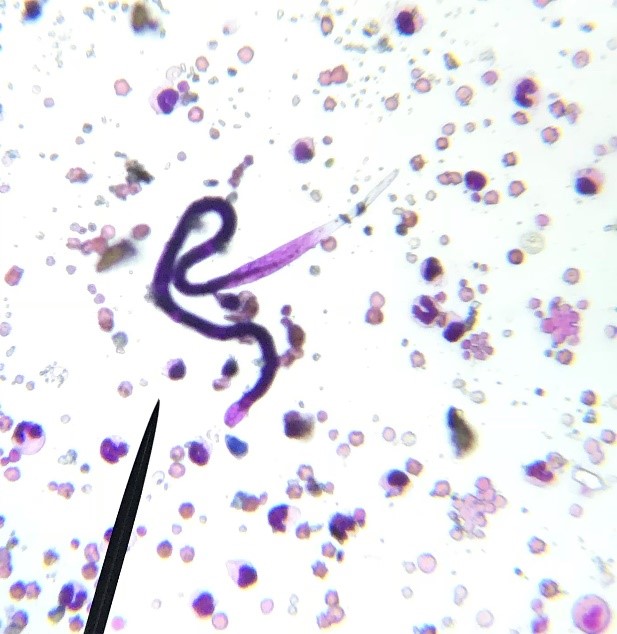Lymphatic Filarial Worms
(Brugia spp.)
Brugia spp. are nematodes that cause lymphatic filariasis in humans. Dogs, and especially cats, are considered to be reservoirs of human infection yet rarely show clinical signs themselves when infected.
Distribution
Brugia malayi and B. pahangi are limited to Southeast Asia and India, whereas B. patei is reported in Kenya.
Clinical signs
Cats infected with B. malayi and B. pahangi are mostly asymptomatic and tolerate infection well. There have been limited reports of infected cats developing lymphadenopathy and lymphedema.

Figure 1 Brugia sp. sheathed microfilaria in the blood smear of a cat (Photo credit: Dr. R. Traub, Dr. Sangaran)
Diagnosis
The diagnosis of Brugia spp. infections in cats can be made upon detection of the sheathed microfilariae using a modified Knott’s technique (Fig. 1). Serological assays such as ELISA can also be used to confirm a diagnosis through the detection of antibodies or antigen. PCR with sequencing is useful for detection of low parasitaemia and for species determination.
Treatment
Brugia spp. infections in cats can be treated with a combination of doxycycline and ivermectin [1] or moxidectin or selamectin.
Prevention and Control
Monthly administration of heartworm preventatives (e.g. moxidectin spot-on, selamectin spot-on) is likely to also protect against feline lymphatic filariasis.
Public health considerations
Brugia malayi and B. pahangi are both zoonotic and there have been several reports in humans in endemic areas.
References
[1] Khowawisetsut L, Sarasombath PT, Thammapalo S, Loymek S, Korbarsa T, Nochote H, Phuakrod A, Choochote W, Wongkamchai S. Therapeutic trial of doxycycline plus ivermectin for the treatment of Brugia malayi naturally infected cats. Vet Parasitol. 2017;245:42-47.
